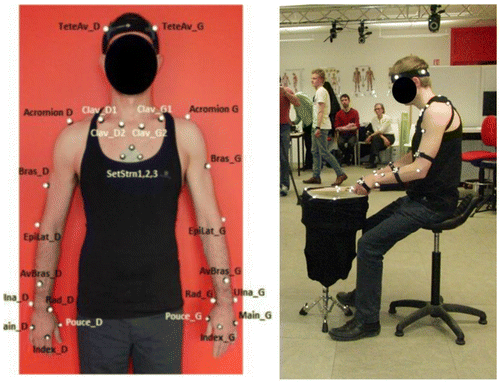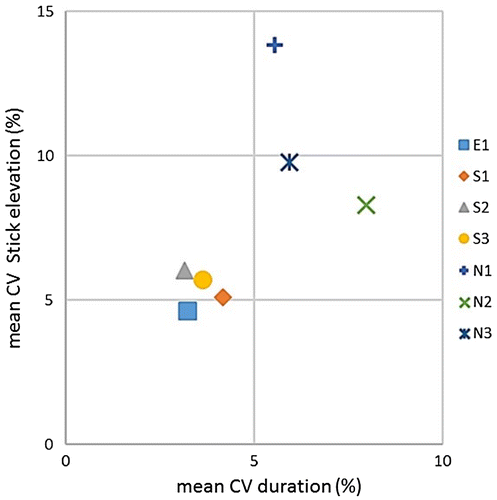1. Introduction
Music expertise is the consequence of techniques and skills acquired over a long time of practice (Cadoz et al. Citation2000). Moreover sound-producing gestures are key for high quality music production (Godøy et al. Citation2006). The snare drum is a classical instrument for percussionists that requires many years of instruction and practice in order to achieve the production of a quality performance (Rooyen et al. Citation2015).
The aim of the present study is to analyse the parameters of the sound producing gesture based on a motion analysis, focusing on qualifying the level of expertise of the musicians.
2. Methods
2.1 Experimental protocol
7 participants took part in the study. The subject E1 had an expert level of practice of percussion and a professional concert experience. Subjects S1, S2 and S3 were advanced percussionist students of a music school. Subjects N1, N2 and N3 were novices with a naïve practice of music.
Motion capture sessions were performed using a Vicon system with 36 cameras at 100 Hz. Marker sets permitted the localisation of the upper body, arms, hands, sticks and snare drum (Moulart et al. Citation2016).
The subject was asked to perform repeated strokes with each hand at 4 different speeds representing a ratio of 1:6. In musical terms, they performed the following score: 1/ four quarter-notes with each hand (twice); 2/ four eighth notes with each hand (four times); 3/ four sixteenth-note with each hand (four times); 4/ one sextuplet with each hand (four times). For the novices, they could practice until they felt comfortable to achieve the complete score. For music students, trials were performed under the supervision of their professor. The subject decided which record would be saved based on own level of satisfaction of his music performance.
2.2 Postprocessing
After 3D reconstruction and labelling using a Nexus software (version 2.5), the motion capture data was exported and calculations were performed with custom Matlab functions.
First, all external markers trajectories were transferred into the snare drum reference frame built with the markers located on it. The z-axis was considered the normal direction of drum skin. Knowing the geometry of the drum sticks, 3D trajectories of the tips of the sticks were computed.
Based on the z-coordinate of the tip of the sticks, for each hit, the duration and the maximal elevation of the stick between two consecutive hits were calculated.
In order to quantify the consistency of the performances the coefficient of variation (CV in %) was considered.
3. Results and discussion
The challenge of this study was to quantify the motion and score of the musician the most accurately possible as well as to make the protocol reproducible.
Results showed that both the expert musician and advanced music students presented a similar quality of music performance in terms of variability of the durations between two strokes at different speeds (quarter note to sextuplets notes) (Figure ). On the contrary, novices had higher values of coefficient of variation, which demonstrated a lesser ability to reproduce their strokes in a constant manner: both stick elevation and timing between each stroke showed a wider range of realisations, indicating a lower control on stick movements. The fact that advanced and expert musicians scores are grouped around or just below a 5% CV, could also indicate that there is a threshold delimiting a sufficient level of control to perform at professional level.
Our results confirmed that motion analysis can quantify the expertise of the musician (Marin et al. Citation2016). In addition, in the case of snare drum practice, the musical performance is demonstrated as being related to the ability to accurately control the 3D displacements of the stick.
4. Conclusions
3D motion capture of musicians vs. non musicians validated the hypothesis that music performance is highly related to spatiotemporal gesture skills. This type of analysis could help the music professors to focus on specific exercises with the aim to train for a 3D gesture reproducibility. The present study was only focused of the stick’s motion, however if a full body marker set was placed on the subject, this would allow to further explore the relationship between the motion of the body and music production. Finally, music performance could be a promising paradigm allowing to monitor neuro-muscular evolving pathologies.
Acknowledgements
This work has received support from “Agence National de Recherche” ANR-11-IDEX-0004-02 under Idex “Sorbonne Universités” in the investments for the future program.
References
- Cadoz C, Wanderley MM. 2000. Gesture-Music Trends in Gestural Control of Music, 71–93.
- Godøy RI, Haga E, Jensenius AR. 2006. Playing “air instruments”: mimicry of sound-producing gestures by novices and experts. Lecture Notes in Computer Science. 3881:256–267.10.1007/11678816
- Marin F, Ben Mansour K, Moulart M, Vahabzadeh F, Mifune M-F, Marandola F. 2016. 3D Motion analysis of the performance of expert musicians. Proc. International Society for Gesture Studies (ISGS7), 67.
- Moulart M, Ben Mansour K, Mifune M-F, Vahabzadeh F, Marandola F, Marin F. 2016. Expert Musician’s sound-producing gestures analysis using 3D motion capture. Proc. 22nd Congress of the European Society of Biomechanics.
- Rooyen RV, Schloss A, Tzanetakis G. 2015. Proc. the International Conference on New Interfaces for Musical Expression, 329:330.


